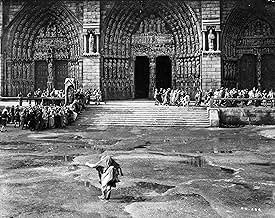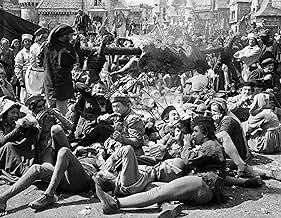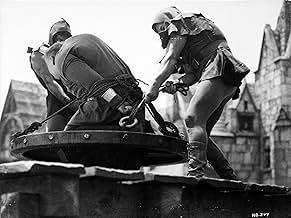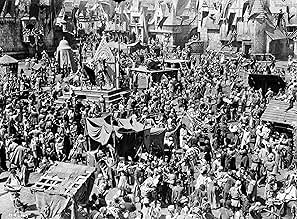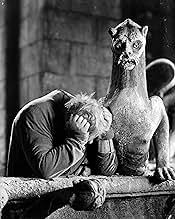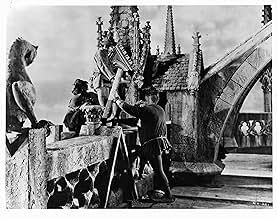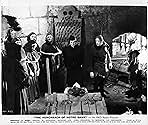PUNTUACIÓN EN IMDb
7,8/10
13 mil
TU PUNTUACIÓN
En la Francia del siglo XV, una gitana es inculpada de asesinato por un juez, y solo el deformado campanero de la catedral de Notre Dame puede salvarla.En la Francia del siglo XV, una gitana es inculpada de asesinato por un juez, y solo el deformado campanero de la catedral de Notre Dame puede salvarla.En la Francia del siglo XV, una gitana es inculpada de asesinato por un juez, y solo el deformado campanero de la catedral de Notre Dame puede salvarla.
- Dirección
- Guión
- Reparto principal
- Nominado para 2 premios Óscar
- 1 premio y 2 nominaciones en total
Cedric Hardwicke
- Frollo
- (as Sir Cedric Hardwicke)
Helene Reynolds
- Fleur de Lys
- (as Helene Whitney)
Minna Gombell
- Queen of Beggars
- (as Mina Gombell)
Rod La Rocque
- Phillippe
- (as Rod LaRocque)
Reseñas destacadas
Though the French have done many versions of Victor Hugo's celebrated classic, this version starring Charles Laughton has certainly stood the test of time and is the best known and loved in the English speaking world.
Lon Chaney, Sr. did an acclaimed silent version of The Hunchback of Notre Dame and Laughton was following a great tradition. And he did it in the manner of Chaney, almost without dialog. Not that Hugo wrote too much dialog for Quasimodo in his story, but except for his time with Esmerelda in the tower after he rescues her, Laughton is almost speechless in the film. Of course his character in addition to being deformed is also deaf from the ringing of those cathedral bells.
Quasimodo born deformed as he was, was left as an orphan on the steps of the Notre Dame cathedral in medieval Paris. Raised in the sheltered atmosphere of the church, he derives some joy in his duties as the bell ringer in the tower. His mentor is the brother of the archbishop played by Cedric Hardwicke and the archbishop is Walter Hampden. Quasimodo's life is useful, but without love.
But Laughton is crushing out on Esmerelda the gypsy girl played by Maureen O'Hara in her American screen debut. Problem is that Hardwicke is also getting hot and bothered by her.
Hardwicke's role is the second best acted in the film next to Laughton's. He's a man with shall we say some issues. He's purportedly committed to the church and it's celibacy requirements. But Dr. Freud wasn't around back in the day of Louis XI to tell us about sex drives. Hardwicke's desires mean only one thing, Esmerelda has to have bewitched him. When he kills Alan Marshal who is also interested in Maureen and looks like he's about to round third so to speak, the blame goes on Maureen.
What I like about the story is how the lives of two very ordinary people, Quasimodo and Esmerelda, become the focal point for a whole lot of religious and political issues of the day. The church, the peasants, the just developing middle class, and the nobility all have an agenda as far as the Esmerelda murder case is going. The only agenda poor Quasimodo has is he's in love with her.
Maureen O'Hara who was a discovery of Charles Laughton back in the United Kingdom was pushed by Laughton for the role of Esmerelda and traveled with him to America to play the part. She was grateful to him ever afterwards for any career she had and can't praise him enough for getting RKO to sign her.
Harry Davenport probably plays the most benign Louis XI ever put on film. It sure is a far cry from Basil Rathbone in If I Were King or Robert Morley in Quentin Durward. He plays him like the kindly grandfather he usually plays on screen.
Thomas Mitchell as Clopin the king of beggars and Edmond O'Brien as Gringoire the poet are two other significant roles. O'Brien gets his first substantial role on screen in The Hunchback of Notre Dame and this was a banner year for Thomas Mitchell. In 1939 he was also in Mr. Smith Goes to Washington, Gone With the Wind and Stagecoach for which he won Best Supporting Actor. He could have though for any one of these films.
When all is said and done though the film belongs to Charles Laughton who was the screen's best portrayer of tortured humanity. Even beneath all of Bud Westmore's grotesque make-up we can feel his anguish. He's not a stupid man Quasimodo, he knows how repulsive he is to most of the human race. He's childlike though, something like Peter Sellers in Being There, another character raised in a secluded atmosphere.
To see Charles Laughton at the top of his game in my humble opinion one has to see The Hunchback of Notre Dame.
Lon Chaney, Sr. did an acclaimed silent version of The Hunchback of Notre Dame and Laughton was following a great tradition. And he did it in the manner of Chaney, almost without dialog. Not that Hugo wrote too much dialog for Quasimodo in his story, but except for his time with Esmerelda in the tower after he rescues her, Laughton is almost speechless in the film. Of course his character in addition to being deformed is also deaf from the ringing of those cathedral bells.
Quasimodo born deformed as he was, was left as an orphan on the steps of the Notre Dame cathedral in medieval Paris. Raised in the sheltered atmosphere of the church, he derives some joy in his duties as the bell ringer in the tower. His mentor is the brother of the archbishop played by Cedric Hardwicke and the archbishop is Walter Hampden. Quasimodo's life is useful, but without love.
But Laughton is crushing out on Esmerelda the gypsy girl played by Maureen O'Hara in her American screen debut. Problem is that Hardwicke is also getting hot and bothered by her.
Hardwicke's role is the second best acted in the film next to Laughton's. He's a man with shall we say some issues. He's purportedly committed to the church and it's celibacy requirements. But Dr. Freud wasn't around back in the day of Louis XI to tell us about sex drives. Hardwicke's desires mean only one thing, Esmerelda has to have bewitched him. When he kills Alan Marshal who is also interested in Maureen and looks like he's about to round third so to speak, the blame goes on Maureen.
What I like about the story is how the lives of two very ordinary people, Quasimodo and Esmerelda, become the focal point for a whole lot of religious and political issues of the day. The church, the peasants, the just developing middle class, and the nobility all have an agenda as far as the Esmerelda murder case is going. The only agenda poor Quasimodo has is he's in love with her.
Maureen O'Hara who was a discovery of Charles Laughton back in the United Kingdom was pushed by Laughton for the role of Esmerelda and traveled with him to America to play the part. She was grateful to him ever afterwards for any career she had and can't praise him enough for getting RKO to sign her.
Harry Davenport probably plays the most benign Louis XI ever put on film. It sure is a far cry from Basil Rathbone in If I Were King or Robert Morley in Quentin Durward. He plays him like the kindly grandfather he usually plays on screen.
Thomas Mitchell as Clopin the king of beggars and Edmond O'Brien as Gringoire the poet are two other significant roles. O'Brien gets his first substantial role on screen in The Hunchback of Notre Dame and this was a banner year for Thomas Mitchell. In 1939 he was also in Mr. Smith Goes to Washington, Gone With the Wind and Stagecoach for which he won Best Supporting Actor. He could have though for any one of these films.
When all is said and done though the film belongs to Charles Laughton who was the screen's best portrayer of tortured humanity. Even beneath all of Bud Westmore's grotesque make-up we can feel his anguish. He's not a stupid man Quasimodo, he knows how repulsive he is to most of the human race. He's childlike though, something like Peter Sellers in Being There, another character raised in a secluded atmosphere.
To see Charles Laughton at the top of his game in my humble opinion one has to see The Hunchback of Notre Dame.
Considering that RKO was not renowned for epic film making, the production mounted for this version of Victor Hugo's classic story is surprisingly elaborate and effective.
The Paris set is a beautiful creation and possibly the greatest work by Van Nest Polglase, who with the producer Pan Berman is chiefly remembered today for the elegant art-deco designs for the Astaire-Rogers musicals.
The centrepiece of this remarkable set is the replica of Notre Dame cathedral which was only built to 50% height of the original; the towers above were added as an optical effect by use of a hanging miniature in some shots and by incorporating a glass painting in long shots. It's very convincing.
Dieterle was the perfect choice to direct this story. A student (and later collaborator) of Max Reinhardt, he marshals the huge crowd scenes (no CGi here - those thousands of peasants are all real people) with aplomb and his mastery of expressionistic imagery informs every frame.
Alfred Newman brought an intelligence to the musical score rare in Hollywood. His on screen credit "Musical adaptation and original composition by" reflects his skillful combining of original renaissance choral music by Tomas Luis de Victoria with his own work. He also uses a stirring Hallelujah chorus by uncredited Austrian Jewish émigré Ernst Toch (in Hollywood to escape the Nazis) for the memorable scene where Quasimodo rescues Esmeralda, reprised at the film's closing sequence as the camera pulls back from Notre Dame.
It's a great pity that a better restoration cannot be achieved for this beautiful film than is currently available on DVD. While the source print is serviceable, it is often poorly defined and suffers from many scratches. Perhaps it is the only print now extant? I would also love to see the original trailer rather than the re-release version.
While some may wish Basil Rathbone could have been released from contract at Universal to play Frollo, I think Cedric Hardwicke was ideal casting. As for Laughton, this may well be his signature role and a masterly example of great acting with hardly any dialogue at all.
As Mr Sinatra once said - "You can wait around and hope - but you won't see the likes of this again"
The Paris set is a beautiful creation and possibly the greatest work by Van Nest Polglase, who with the producer Pan Berman is chiefly remembered today for the elegant art-deco designs for the Astaire-Rogers musicals.
The centrepiece of this remarkable set is the replica of Notre Dame cathedral which was only built to 50% height of the original; the towers above were added as an optical effect by use of a hanging miniature in some shots and by incorporating a glass painting in long shots. It's very convincing.
Dieterle was the perfect choice to direct this story. A student (and later collaborator) of Max Reinhardt, he marshals the huge crowd scenes (no CGi here - those thousands of peasants are all real people) with aplomb and his mastery of expressionistic imagery informs every frame.
Alfred Newman brought an intelligence to the musical score rare in Hollywood. His on screen credit "Musical adaptation and original composition by" reflects his skillful combining of original renaissance choral music by Tomas Luis de Victoria with his own work. He also uses a stirring Hallelujah chorus by uncredited Austrian Jewish émigré Ernst Toch (in Hollywood to escape the Nazis) for the memorable scene where Quasimodo rescues Esmeralda, reprised at the film's closing sequence as the camera pulls back from Notre Dame.
It's a great pity that a better restoration cannot be achieved for this beautiful film than is currently available on DVD. While the source print is serviceable, it is often poorly defined and suffers from many scratches. Perhaps it is the only print now extant? I would also love to see the original trailer rather than the re-release version.
While some may wish Basil Rathbone could have been released from contract at Universal to play Frollo, I think Cedric Hardwicke was ideal casting. As for Laughton, this may well be his signature role and a masterly example of great acting with hardly any dialogue at all.
As Mr Sinatra once said - "You can wait around and hope - but you won't see the likes of this again"
10llltdesq
The best of the many versions of The Hunchback of Notre Dame, for my money, is this one, although Lon Chaney's is a close second. Despite a Hollywood tendancy to change the novel's ending so as not to depress the cash customers (although, pray tell, if you're going to change the ending, why does no one ever see Quasimodo sailing off to Tahiti with the girl? Rule # 1: strong, handsome poets beat out disfigured cripples every time, even if they're heroes. This is more true in real life than in the movies. Take my word for this, I know from painful experience *sigh*)
Charles Laughton is exceptional and Maureen O'Hara would make any man swoon and is perfect for the part of Esmerelda. The support includes the usual suspects-Thomas Mitchell, Harry Davenport and many other familiar character actors. Strike up the band and start the parade. Thunderous applause. Most highly recommended.
Charles Laughton is exceptional and Maureen O'Hara would make any man swoon and is perfect for the part of Esmerelda. The support includes the usual suspects-Thomas Mitchell, Harry Davenport and many other familiar character actors. Strike up the band and start the parade. Thunderous applause. Most highly recommended.
I remember `Super Channel' showed this regularly about 10 years ago. The opening 1/2 hour is superb, with several outstanding scenes and very haunting music.The cast is brilliant, not only do you get Laughton but also Maureen O'Hara, Cedric Hardwicke and Edmon O'Brien. And Thomas Mitchell is the man! All in all a most satisfying film: 8.5 out of 10
Losy in the monatge of 1939 films ...somewhat is a film I believe is more enriching and florid than " Gone With The Wind" and possibly just as romantic as " Wuthering Heights"
Laughton's performance is one of the most astonishing put on film ever. A Stellar cast is in place from O' Hara to O' Brien..What can I say , Thomas Mitchell who probably graced more films than any other actor is superb.
Hugo,s timeless classic is brought to life in black and white and with sets that make you feel ..you are there.
The great Cedric Hardwicke potrays the tormented one and for sure ..its 116 minutes of pure film making ..and it all takes place on fools day....
CP
Laughton's performance is one of the most astonishing put on film ever. A Stellar cast is in place from O' Hara to O' Brien..What can I say , Thomas Mitchell who probably graced more films than any other actor is superb.
Hugo,s timeless classic is brought to life in black and white and with sets that make you feel ..you are there.
The great Cedric Hardwicke potrays the tormented one and for sure ..its 116 minutes of pure film making ..and it all takes place on fools day....
CP
¿Sabías que...?
- CuriosidadesThe scene in which Quasimodo rings the cathedral bells for Esmeralda was shot the day World War II began in Europe. The director and star were so overwhelmed, the scene took on a new meaning, with Charles Laughton ringing the bells frantically and William Dieterle forgetting to yell "cut." Finally, the actor just stopped ringing when he became too tired to continue. Later, Laughton said, "I couldn't think of Esmeralda in that scene at all. I could only think of the poor people out there, going in to fight that bloody, bloody war! To arouse the world, to stop that terrible butchery! Awake! Awake! That's what I felt when I was ringing the bells!"
- PifiasThe cathedral is shown as having a full flight of steps up to the front doors. Notre Dame has always been more or less level with the square (le Parvis).
- Citas
[Last lines]
Quasimodo, the bell-ringer: [to one of the stone gargoyles] Why was I not made of stone - like thee?
- Créditos adicionalesPROLOGUE: "With the end of the 15th Century, the Middle Ages came to a close. Europe began to see great changes. France, ravaged by a hundred years of war, at last found peace. The people under Louis XI felt free to hope again --- to dream of progress. But superstition and prejudice often stood in the way, seeking to crush the adventurous spirit of man."
- Versiones alternativasAlso available in a computer colorized version.
- ConexionesEdited into The Clock (2010)
- Banda sonoraAve Maria
(1572) (uncredited)
Music by Tomás Luis de Victoria
Sung by mixed chorus during opening credits
Selecciones populares
Inicia sesión para calificar y añadir a tu lista para recibir recomendaciones personalizadas
- How long is The Hunchback of Notre Dame?Con tecnología de Alexa
- What is 'The Hunchback of Notre Dame' about?
- Is "The Hunchback of Notre Dame" based on a book?
- In what year is the story set?
Detalles
- Fecha de lanzamiento
- País de origen
- Sitio oficial
- Idioma
- Títulos en diferentes países
- El geperut de Notre-Dame
- Localizaciones del rodaje
- Empresa productora
- Ver más compañías en los créditos en IMDbPro
Taquilla
- Presupuesto
- 1.800.000 US$ (estimación)
- Duración1 hora 56 minutos
- Color
- Relación de aspecto
- 1.37 : 1
Contribuir a esta página
Sugerir un cambio o añadir el contenido que falta

Principal laguna de datos
What is the French language plot outline for Esmeralda, la zíngara (1939)?
Responde

